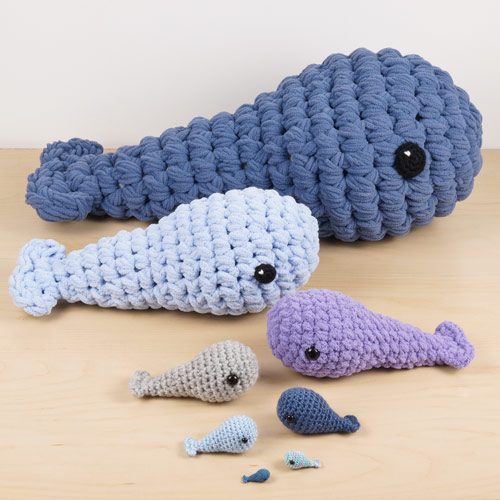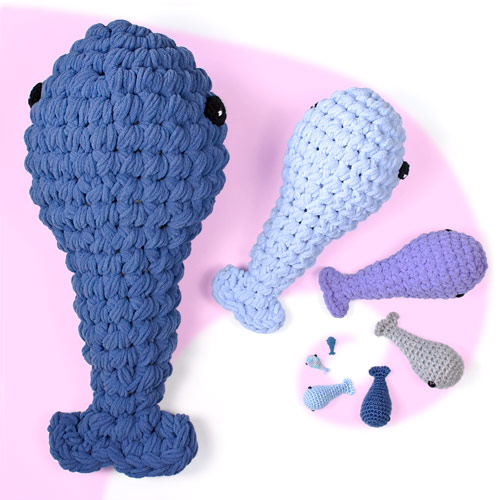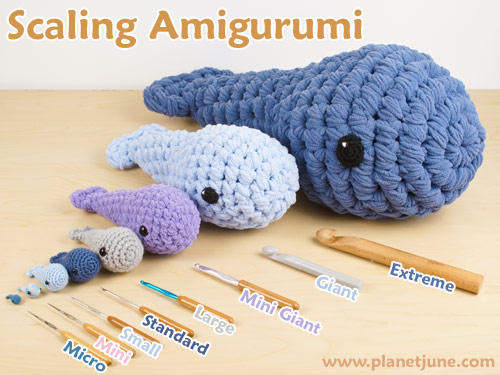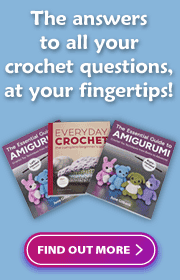I’m often asked how to scale one of my amigurumi patterns up or down by a specific amount. It’s hard to answer that without relevant data, so that means it’s time for another crochet experiment – yay!
Want to skip straight to the results? Jump straight to the Scaling Amigurumi to Any Size tutorial.
Method
I made 8 versions of my Tiny Whale pattern, ranging from the largest 25mm hook I own down to the smallest hook I felt I could manage (0.9mm), and choosing the most appropriate yarn size for each hook.

Of course, it’s possible to crochet outside this range – massive 40mm hooks exist (or you can crochet using your whole hand instead of a hook!), and some talented people are able to crochet with sewing thread and a 0.4mm hook – but I had to set some limits for my experiment…
The three dark blue whales in my photos mark these limits: largest, smallest, and the standard size (made with worsted weight yarn and a US E/3.5mm hook).
I’ve named all eight sizes so we have something to refer to throughout this post, from largest to smallest (and top to bottom in the photo above):
- Extreme Amigurumi
- Giant Amigurumi
- Mini Giant Amigurumi
- Large Amigurumi
- Standard Amigurumi – regular amigurumi!
- Small Amigurumi
- Mini Amigurumi
- Micro Amigurumi
The difference in scale is incredible – one stitch of an Extreme Amigurumi whale is larger than an entire Micro Amigurumi whale!

And here’s a top-down photo of all 8 sizes (this is a single photo so the scale is exact; the only editing I did was to add the pink spiral for clarity):

Look for the three dark blue whales to see the differences in size between the Standard size and the Micro (smallest) and Extreme (largest). Isn’t that something?!
Calculations
Time to quantify those differences. To get an idea of the scale change, I took four measurements from each of my whales:
- the average width of one stitch (sampled over several stitches for higher accuracy)
- the average height of one round (sampled over several rounds for higher accuracy)
- the overall length of the whale
- the width of the whale at its widest part
Then, for each whale, I compared each measurement with the same measurement on my standard sized whale (made with worsted weight yarn and a US E/3.5mm hook). I used the average of the four comparisons, rounded to a nice number, to give me an approximate overall scale factor for each amigurumi size.
There’s a lot of variability here – not only in the numbers I measured from my samples and the accuracy of my measurements, but in the difference between specific yarn and hook combinations and the individual crocheting style of each crocheter – so a rough conversion factor is the best we’re going to get.
My scale factor is not intended to be an accurate number, but a rough idea of the size difference you can expect from scaling up or down.
Results

UPDATE: Note that I’ve replaced my original ‘Mini Giant’ scale that you see in this post with the ‘Double’ scale, which, although it isn’t as large at 2x scale, makes for a better amigurumi toy, with sturdier fabric and smaller gaps between the stitches. (For reference, Mini Giant used the same yarn as Double with a larger L hook, to make a 2.4x size amigurumi.)
I’ve created a table of results that you can use as:
- A starting point for figuring out how big your amigurumi will be when you use a different yarn and hook
- A reference for the yarn and hook sizes to choose to make an amigurumi of a specific size
I hope you’ll find it as helpful as I do!
















jan said
This is awesome! I was looking for scale because doing beaded croshet uses thread. I’m specifically using toho 11/0 and 15/0 size beads. The thread is .4, .5 or .6mm depending on need and thread. The hook size is 5mm. This helps as a starting point.
Meredith Edwards said
Thanks so much for doing this- I’m a beginning crocheter, and this is incredibly helpful. I’m not sure you’re still monitoring this page but if you are- do I need to multiply the length of yarn I will need by that scale factor too? Ie 100m of worsted weight translates to 240m of super bulky, to make the exact same pattern?
June said
Meredith, you can use the scale factor to give you a very rough estimate of how much yarn you’ll need, but please be aware that this may not be very accurate. (For the larger sizes, especially, the scale factor is likely to give you an overestimate.) And remember that if you’re holding two strands together – e.g. for the Giant scale – you’ll need to double the yarn quantity, as the yardage you calculate will be for each strand.
Meredith C Edwards said
Thank you so much! I’ll start there, and then once my yarn arrives I’ll do a set of test stitches to get a better idea.
Sam said
Hi, I am new to crochet. For my project, it calls for weight 6 bulky yarn and a 6mm crochet hook. I am confused on which hook I should use to make it bigger than what it calls for. I am Confused if I should change the hook size but I am Not Sure which hook would Be a good size.
June said
Bulky yarn is the ‘Mini Giant’ scale in my table, so if you want to make it larger, look at the ‘Giant’ size info.
Sam said
Thank you
sam said
Hi, I want to make a project bigger but a bigger size hook will create holes in my project so I was wondering if doubling the pattern instead to make it bigger. Would doing that change the structure of the pattern in anyway?
Lisa said
I’m new to crochet, and I bought Bernat blanket yarn and made a rhino. I came to your article afterwards as all my amigurumi critters are seemingly very long. I thought clearly my hook size was out whack and I’m doing something wrong. Looked at your chart, I did indeed use the proper hook. Would this just indicate that my stitches are too tight or loose, and would you happen to know which it is. I have some pretty adorable patterns but they are losing their flare when they come out so long.
June said
The hook sizes I recommended in my table are just a starting point – within a weight category, some yarns are thicker or thinner than others, and your tension (how tightly you crochet) will also make a difference, so there’s no guaranteed ‘proper’ size – the ‘best’ size may be different for each crocheter and each specific yarn.
I’d suggest trying a smaller hook and seeing if that makes a difference.
If not, you’re probably drawing up the first loop of your single crochet too far, so that loop is too long compared with the second loop of the stitch. To make a square stitch, each loop you draw up should be the same size, so the size of the loop around your hook after you ‘insert hook and draw up a loop’ should be the same size as the loop around your hook after you complete the sc stitch.
Liz said
did you alter any of the patterns beaide scaling up? like did you add more inc/dec at all?
June said
No, the whole point of this experiment was that I followed exactly the same pattern for every single size – the only difference is changing the yarn weight, and choosing an appropriate hook size to match each yarn weight. That means you can use the results of my investigation to resize any amigurumi pattern!
Liz said
Thanks! I’m definitely going to try this this weekend.
Janet Lunn said
Thats the most amazing experiment I have ever seen. I normally always use thinner yarn as I like things smaller but this gives a lot more clarity and will be soooo useful. Thank you for sharinig
Jeannette said
thank you for this very excellen5 and helpfulinformation.
Sheila said
Thanks!. I really didn’t want to make a 17 inch Emu.
Sara Branch said
Thank you so much for the very clear information about scaling amigurumi up and down. My younger son has been very interested in this very topic and asked for Giant, Standard and Mini baby squid which I have provided for him. It’s been a fun experiment.